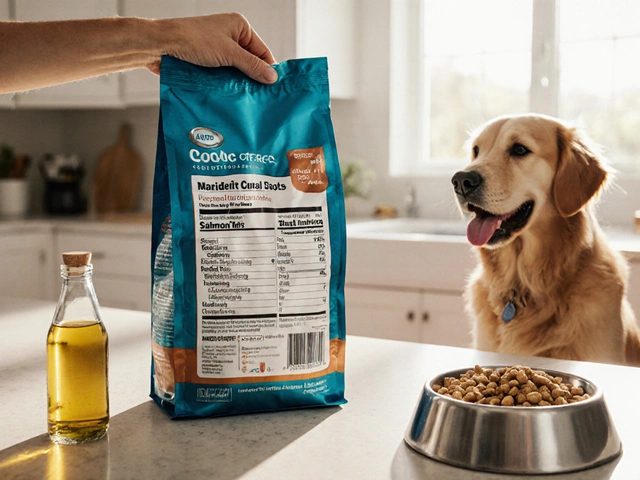In an era where the cost of everything—from groceries to utilities—seems to keep rising, many pet owners are looking into more wallet-friendly alternatives to commercial dog food. The question of affordability often nudges people towards exploring homemade solutions.
However, while balancing value with nutrition can be tricky, it is absolutely possible to feed your dog well without stretching your pockets too thin. We'll dive into the essentials of dog nutrition and offer some practical homemade recipes that are both nutritious and kind to your budget.
Feeding your dog homemade food isn't just about saving money, it's about knowing exactly what goes into their bowl. By selecting the right combination of ingredients, you can ensure your dog stays healthy and satisfied, all while feeling a little relief in your monthly expenses. Let's explore what these homemade meals could look like and how you can safely implement them into your dog's diet.
- Understanding Dog Nutrition Needs
- Homemade Dog Food Recipes
- Economical Ingredients for Dogs
- Safety Considerations and Tips
Homemade Dog Food Recipes
Making homemade dog food recipes can be a genuinely rewarding venture, both for the pet and the owner. Not only does it promise a fresh and nutritious meal tailored just for your fur baby, but it also offers peace of mind as you control every ingredient that goes into the bowl. Unlike commercial options, homemade meals can be free of preservatives and additives that might not sit well with certain dogs. The key, however, lies in understanding the basics of canine nutrition and tweaking recipes to suit your dog's specific dietary needs.
For a start, it's important to balance proteins, carbohydrates, and fats, while ensuring a healthy dose of vitamins and minerals. Proteins like chicken, turkey, or beef should make up a significant portion of the diet. Whole grains such as brown rice or quinoa provide the carbohydrates needed for energy. Vegetables like carrots, peas, and sweet potatoes add necessary vitamins and fiber, while a small amount of fats from sources like fish oil can keep your dog's coat shiny. All of these should be prepared in a way that is easy to digest for your dog; steaming or boiling is often the preferred method. Always ensure that each meal includes the right nutrients tailored to your dog’s size, age, and activity level.
One of the simplest DIY recipes involves mixing ground chicken with brown rice and a variety of vegetables. Start by cooking the chicken thoroughly in a pan, making sure it's fully browned. Next, boil the rice until it becomes soft and fluffy. Combine the chicken and rice, then add in steamed carrots and peas. For an added nutritional kick, sprinkle in some ground flaxseed that contributes essential Omega-3 fatty acids. Once mixed well, allow the meal to cool before serving it to your dog. Remember, though, this is just a base - feel free to customize it with other dog-safe veggies or proteins your dog loves.
It's not just about whipping up meals, but also about introducing variety to prevent nutritional gaps and simply making it interesting for your pet. Dogs enjoy variety just as much as humans, so alternate between proteins and include seasonal vegetables. A well-rounded diet can keep your dog engaged and less tempted to refuse meals. It’s worth taking notes on your dog’s preferences and any digestive issues they might experience. As you progress, you'll learn what works best, keeping notes on anything new you try.
“The trick lies in understanding what makes your dog thrive and evolve dietary needs over time,” says Dr. John Carter, a reputable vet known for his holistic approach to pet care.
If you're new to this, remember that transitioning your dog from commercial food to homemade meals must be gradual. The abrupt introduction of a new diet can upset your dog’s stomach. Start by mixing a small amount of the new meal with the existing one, increasing the proportion of homemade food over a week or more. Monitor your dog closely for any changes in their stool consistency, behavior, or appetite, adjusting the ingredients as needed. Staying attuned to these subtle changes ensures better assimilation of the new diet.
Keep in mind these simple guidelines, and you'll soon find the perfect blend of affordable and nutritious food for your dog. The love and attention you put into preparing these meals often translate into better health and more wagging tails. By embracing this hands-on approach, not only are you investing in their health but you're also forming a deeper bond, creating memories around meal preparations that you both will cherish.

Economical Ingredients for Dogs
Finding cheap dog food ingredients doesn't mean compromising on quality. When you delve into preparing meals for your dogs at home, the vast selection of ingredients available at your local market can be both affordable and nutritious. Start off with protein sources, which are the cornerstone of a dog's diet. Chicken, particularly thighs or drumsticks, is often more affordable than chicken breast, and when bought in bulk can save you a good amount of money. Likewise, fish such as sardines and whitefish can be economical and are loaded with Omega-3 fatty acids, enhancing your dog’s shiny coat.
The next step to explore would be grains and carbohydrates, which are essential for providing energy. Rice, particularly brown rice, is a fantastic option as it’s relatively cheap and stores well. Oats are another excellent grain source and are easy to prepare; they offer a variety of benefits like improving digestion and even helping with some skin conditions. Adding sweet potatoes or regular potatoes can provide an added nutritional punch as well as a different texture and flavor that most dogs love.
Don’t overlook the power of vegetables, which can be rich in vitamins and minerals. Carrots and peas are not only cost-effective but also offer a pleasant crunch that dogs often enjoy. Spinach and kale, when used in moderation, can provide vital nutrients, though it’s always crucial to cook them to eliminate any oxalates that can cause kidney problems in excess. Blending these veggies can make it easier for dogs to digest.
Eggs are yet another affordable and potent source of nutrition for dogs. They are packed with protein and essential amino acids, and don't require any fancy preparation—simple boiling does the trick. A lesser-known hero in dog nutrition is pumpkin, offering fiber and beta-carotene; it’s ideal for regulating digestion and is usually well-received by dogs.
It's crucial to maintain balance and variation in your selected ingredients. This helps cover all nutritional bases while also keeping your pet's meals interesting. Make sure to keep portion sizes in mind, adjusting them according to your dog’s size, age, and activity level. A well-balanced list of affordable food choices can ensure your furry friend enjoys a nutritious diet comfortable for you.
"It’s about finding what works for your pet, what you can afford each month, and making sure your dog is getting all the correct dietary components," advises Dr. Sandra Barton, a pet nutritionist and author of "Economical Canine".
Interactive Table of Ingredients Costs
| Ingredient | Approximate Cost (per kg) | Nutrition Highlight |
|---|---|---|
| Chicken Thighs | £3.00 | High Protein |
| Sardines | £1.50 | Rich in Omega-3 |
| Brown Rice | £0.90 | Carbohydrates |
| Carrots | £0.90 | Vitamin A |

Safety Considerations and Tips
When you're exploring alternatives to commercial options like dog food, safety becomes a paramount concern. It's easy to imagine combining leftovers with some kibble and calling it a meal, but dogs have specific nutritional needs that must be met for them to stay healthy. Protein, carbohydrates, fats, vitamins, and minerals all play crucial parts in your pet's diet. So, when designing a homemade meal, ensure it mirrors the balance dogs receive from commercial diets. Take caution to not rely solely on homemade meals unless they are well-researched and properly balanced.
One perennial concern is toxicity. Several human foods, like chocolate, grapes, onions, and garlic, are toxic to dogs, so it's crucial to keep these out of their diet. Understanding which foods fall into the forbidden list can prevent potentially harmful situations. In addition, keeping track of how much your dog is consuming is also important. Overfeeding can lead to obesity, and underfeeding can lead to malnutrition. Both can significantly harm your pet's health. Establish a routine and stick to the quantities that your dog's breed, size, and weight recommend.
Another important aspect to consider is sourcing your ingredients. Not all ingredients are created equal, and the quality of food you provide can greatly impact your dog's health. Opt for fresh, natural ingredients over processed foods whenever possible. Don't compromise on the quality of essential items like protein sources; lean meats such as chicken or turkey work well, and fish can also be a great addition, offering omega-3 fatty acids which are beneficial for a dog's skin and coat.
Just as you'd read up on safe and beneficial foods, checking in with a veterinarian before committing wholeheartedly to a homemade diet is beneficial. This ensures you cover all nutritional bases and your planned meals align with your dog's particular health needs. Not everyone knows the precise needs for different life stages or existing health conditions, and a professional can provide expert guidance. Quoting Dr. Julian Thompson, a respected veterinarian, "A well-balanced diet is the foundation of good health, and when experimenting with homemade food, professional advice can be invaluable."
Tracking any transitions you make from commercial food to homemade alternatives can be invaluable. Observing changes in your pet's behavior, weight, coat condition, and general health can inform you whether your approach is working or needs adjustments. Keeping a food journal could be a helpful way of tracking what meals work best for your dog. In the initial phase, slowly integrate new foods and monitor carefully how they affect your dog. Drastic dietary changes can upset your dog's stomach, leading to gastrointestinal problems. Slow and steady is key.
As a helpful overview, here’s a simple guide to follow when preparing homemade food for your dog:
- Consult with a veterinarian for advice tailored to your dog's specific needs.
- Avoid foods toxic to dogs, such as chocolate and grapes.
- Test out different proteins and discover what your dog prefers.
- Track your dog’s responses and adjust meals accordingly.
- Ensure the diet is well-balanced with all necessary nutrients.
With informed choices and a keen eye on your dog’s health and weight, embarking on a homemade food journey can be rewarding. As you step away from traditional dog food options, remember that a thoughtful approach to nutrition will ensure your pet thrives and stays happy.







